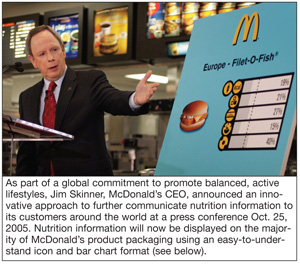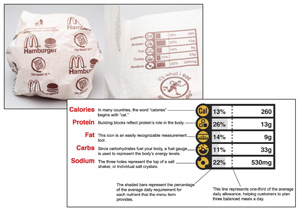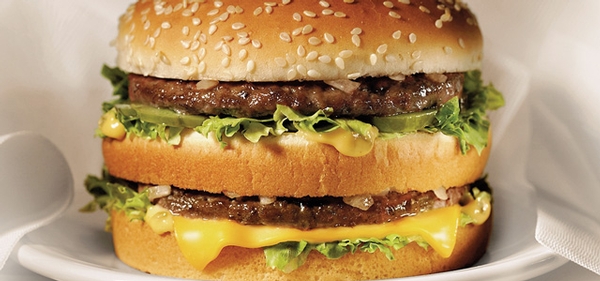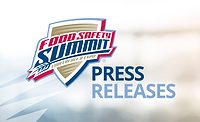In 1975, when McDonald’s Corp. first aired its famous Big Mac jingle—”Two all-beef patties, special sauce, lettuce, cheese, pickles, onions on a sesame seed bun”—the catchy lyrics caught the public’s attention in a big way. So big that 30 years later, most of us who heard it as children still remember all the words, and if asked, will readily recite them in the ditty’s signature beat.
But that pithy list of ingredients, which make up a single McDonald’s branded sandwich, belies a much lengthier list of meat, poultry, produce, dairy, bakery and condiment suppliers with which the global fast food giant contracts to produce the popular hamburger tens of thousands of times a day. A quick glance down the menu board—from McDonald’s world famous French Fries, Quarter Pounder and Egg McMuffin, to a variety of chicken and fish sandwiches, vegetable and fruit salads, dairy and bakery desserts, and beverages—conveys the sizeable number of suppliers required to deliver the goods to the leading global foodservice retailer, which has more than 13,700 restaurants serving nearly 26 million people every day.
It’s not surprising, then, that for a restaurant chain that does billions in revenue sales per year, maintaining food safety across its supply chain is not just a good business initiative, it is paramount to customer safety and business success. At the center of the McDonald’s operation is a supplier food safety and quality assurance program that ranks as a corporate top priority. Suppliers and franchisees must follow rigorous quality and safety guidelines if they want to work with McDonald’s, because in a high-profile business that bases success on a consistent customer experience no matter where you are in the world, setting explicit food safety and quality expectations for suppliers and restaurant employees is the only way to make it work.
“Food safety is a never-ending process for McDonald’s, from raw materials, through the facilities and distribution centers, and all the way to the restaurants,” says Lamont Rumbers, director of quality systems for McDonald’s USA. “It’s a top priority at McDonald’s. It’s a fundamental standard of our business and our heritage, and will never be compromised.”
For example, he says, for sandwich buns alone, the company works with more than 20 bakeries across the U.S.—all of which must not only make the product exactly the same size, color, texture, flavor and consistency, but must show that they are successfully adhering to the stringent food safety guidelines and requirements set by McDonald’s. “When you look at the number of people in that process alone, the challenge is to consistently meet and exceed the expectations that are a top priority for our brand,” Rumbers explains.
The key to successfully meeting that challenge, says Rumbers, is McDonald’s commitment to setting rigorous, science-based food safety and quality assurance standards and then effectively communicating those standards and expectations to its supply chain partners. It’s all about the people and the process. In essence, the Golden Arches presents an overarching gold standard food safety and quality system to its suppliers, franchisees, company and restaurant employees that is designed to be communicated so clearly that its elements are as easy to remember as the ingredients list in the popular Big Mac jingle.
Suppliers Have No Secrets
J.C. González Méndez, McDonald’s North America senior vice president of supply chain management, likes to tell people that McDonald’s itself doesn’t make any of its products. “We purchase everything from our suppliers,” he says. McDonald’s works with thousands of suppliers to purchase everything served in the restaurant, from beef patties and nuggets, to napkins and ketchup packets. “The suppliers are our front line, they are the guardians of quality.”
McDonald’s partners with nationally known and local beef, pork, poultry, produce and egg processors, such as Tyson Foods, Sunny Fresh Farms and Fresh Express, as well as bakery, dairy, condiment, juice, soft drink and produce suppliers like Kraft Foods, Dean Foods, General Mills, Golden State Foods, Dannon, Newman’s Own, McCormick and Coca-Cola. Each supplier—whether a regional apple grower or a multinational food manufacturer—is responsible for the safety, quality and consistency of the products they produce and deliver into the McDonald’s supply stream.
As part of the business relationship, Rumbers and dozens of other McDonald’s quality assurance personnel talk daily with each supplier about their processes, discussing expectations, challenges and ideas for improvement. McDonald’s sponsors councils on quality and diversity and product-themed committees for beef, chicken and other product categories within its supplier community that foster communication among the restaurant owners, suppliers and corporate representatives.
“The closeness of these relationships is our strength,” Rumbers says, noting that many McDonald’s innovations have come from individual owner operators and suppliers who had ideas to improve processes or to improve or add to the restaurant’s product lines. Ideas that have been realized include the improvement of production processes to reduce waste and the invention of the Big Mac and McGriddles sandwiches. “There are no sacred cows at McDonald’s,” he says of the corporation’s open-door communication policy. And there are no secrets. “It’s a requirement of every McDonald’s supplier to share their best practices with other suppliers, and to invite each other into their facilities.”
Suppliers are also expected to send their products to other suppliers in their categories and to participate in corporate product comparison tests to judge characteristics, such as taste, thickness, color and quality. The supplier of the product with the highest score (based on meeting target product specification) will share its products with other McDonald’s suppliers in that product category to help them improve their product specifications.
Getting Through the Golden Arches
It is no small task to become a McDonald’s supplier. Many have been with the company for decades and produce product exclusively for the company, while others have additional clients but contribute a significant portion of their operations to dedicated McDonald’s production.
All suppliers must be willing and able to meet McDonald’s stringent food safety and quality standards, which include dedicated production lines, storage facilities and production formulas. The McDonald’s system requires constant quality checks throughout the supply chain process and proven traceability programs, at least one step back to the ingredient supplier, and in some cases, tracking all the way back to the farm. The suppliers are expected to audit their own ingredient and raw material suppliers to ensure that those producers upstream also meet the high food safety and quality requirements of the company, which includes the implementation of Hazard Analysis and Critical Control Points (HACCP) and allergen control programs.
Having an adequate HACCP program is the cornerstone of McDonald’s’ food safety program for its suppliers, and the minimum requirement to work with the company, Rumbers says, noting that McDonald’s was an early adopter of the HACCP food safety system model. “We want to see their food hazard prevention, control and sanitation programs in action. We want to see that they work and adhere to local, state and federal regulations in addition to our specific requirements.”
To verify that vendor quality assurance and food safety programs are working effectively and meet the restaurant chain’s rigorous specifications, third party auditors and company representatives regularly tour suppliers’ facilities to observe food safety and sanitation programs as they are executed. As a part of verifying the adequacy of a production plant’s sanitation practices, auditors conduct thorough reviews and risk assessments of each supplier’s HACCP program, considering how the HACCP plan was developed, how the hazard analysis was conducted, how the process critical control points were identified, and whether the program is aligned with McDonald’s expectations for quality and safety. The facility’s HACCP program is further evaluated to assess how the program works in the production environment under varying workload conditions and to verify that it is being implemented across the facility at all times. Additionally, auditors will swab processing equipment, food-contact surfaces and nonfood-contact surfaces such as floor drains to check the level of cleanliness and hygiene of the production environment and periodically take equipment apart for further hygiene monitoring inspections.
McDonald’s also works with third party auditors to conduct announced and unannounced audits in the facilities of all of its direct suppliers about twice a year. If issues or gaps in food safety or quality systems are found, McDonald’s works with the supplier to resolve potential problems before they ever interfere with product safety and quality.
To accommodate and adhere to McDonald’s food safety and quality requirements, most of the company’s suppliers have dedicated quality assurance staff on-site for the McDonald’s brand products they produce. In return, McDonald’s encourages suppliers to share ideas and to constantly challenge the way the company and other suppliers think about quality and food safety. “They allow us to offer suggestions on how to enhance quality throughout processing,” says Wendy Davidson, group vice president of food service for Tyson Foods, the Springdale, AR-based supplier of chicken and other protein-based products to McDonald’s worldwide. “It’s very collaborative. Without this kind of interactive relationship, it would be much more challenging.”
Along with a willingness to meet McDonald’s strict criteria, suppliers also have to be able to prove they can meet demand. This is a key issue for McDonald’s, which can’t change its menu to meet seasonal or geographical changes and must be able to supply 30,000 restaurants year-round. It is especially tricky with products such as fresh produce, which typically have short shelf lives and limited growing seasons. “We need guaranteed year-round supply and quality,” notes Mitch Smith, McDonald’s USA director of quality systems, who says the recent launch of the company’s Fruit & Walnut Premium Salad and Apple Dippers took months of sourcing research. “A main menu item has to be identical in any season. We can’t change apple varieties or use produce that has crop damage.”
The color, cut, texture, freshness and mix of all products must meet exact expectations. That translates into millions of pounds of produce that must be accessible for McDonald’s to meet demand. Last year alone, McDonald’s sourced 80 million pounds of lettuce, 1.5 billion pounds of potatoes, 30 million pounds of tomatoes, and 54 million pounds of apples.
Similarly with meat products, such as chicken filets and beef patties, the cut, size, shape, tenderness and moisture level of each patty or nuggets must be identical. To achieve that, McDonald’s has invested great effort over the years in creating a production system that delivers the same quality and consistency of product, from each batch and every supplier.
Beefing Up Food Safety
Made famous by its all-beef patty burgers, McDonald’s has become the largest single purchaser of American beef, buying nearly one billion pounds per year. As one of the nation’s leading buyers of agricultural products, including beef, the company believes in and has consistently advocated and enforced the strongest possible food safety standards and regulations for all its suppliers.
Otto and Sons, Inc. (OSI), a global beef supplier and one of the first and largest beef suppliers to work with McDonald’s, is a model example of how individual processors integrate the corporate quality and food safety strategies into their own operations. OSI’s dedicated beef processing facility in Aurora, IL, has 200 employees and processes 560,000 pounds of beef per day, serving more than 3,000 McDonald’s restaurants in the Midwest.
As with all McDonalds suppliers, the food safety program at OSI involves constant testing and an enforcable traceability program that tracks ingredients throughout the supply chain and processing environment. “If we need to,” says McDonald’s Rumbers, “we can track a box of patties back to a supplier in 45 minutes.”
OSI’s HACCP and traceability program begins when the raw beef arrives at the door from the slaughterhouse. All certified drivers undergo background checks before being allowed to deliver or receive product for OSI. Every 2,000-lb. truckload of beef is sealed with a traceable, unbreakable bolt that contains a code matched to the bill of lading, verifying which slaughterhouse it’s from and that it hasn’t been tampered with.
If the bolt matches the bill of lading, it is cut with a custom cutting tool. The beef is unloaded and the barcode of each box is scanned into an enterprise-wide tracking software system, where it is given a new tracking number that includes the date, location and time each container is received, and the shelf life of the product. Random loads are sampled for foodborne bacteria, such as coliforms, E. coli and Salmonella.
Once approved, the meat is placed in a 45F storage area within 35 minutes of arrival to maintain temperature control. OSI has a 3.5-million-lb. freezer capacity with flowthrough design for first in, first out (FIFO) processing, to reduce the holding time of any batch of meat.
Throughout processing, there are up to 100 quality checks per hour to ensure that every product meets McDonald’s specifications. Raw meat is regularly checked for temperature to ensure it stays at safe levels. Tests also include ratio of lean to fat meat in the beef mixes, patty size and thickness, flavor, aroma, tenderness and juiciness, as well as product and routine environmental microbiological testing.
Once an hour, a batch of product is randomly pulled and cooked in a standard McDonald’s kitchen, which is set up in the processing facility, to ensure final product has the right level of taste, aroma, moisture, look and feel. The kitchen includes McDonald’s patented clamshell grill to cook all sandwich meats. In the clamshell, meat is placed on the bottom half of the grill first, then the top half, which is also a cooking surface. The clamshell is closed, guaranteeing the meat is cooked through from top to bottom. The grill has a set time and temperature requirement and the clamshell cannot be opened or the patty removed until sensors read that these time and temperature requirements have been reached.
When the patties are packaged, the boxes are given a tracking number that is linked back to the enterprise-wide software system, which allows for quick traceback if a problem arises. Beef suppliers, such as OSI, can track any batch of meat back to the slaughterhouse, and many are working with ranchers and government agencies to develop animal identification tracking systems that link batch information to the individual cow.
Tyson Takes Stock of Its Chickens
Rules for McDonald’s poultry processors are similarly thorough, requiring strict control over the lifespan of every chicken. At Tyson Foods, the key to maintaining food safety parameters and controlling quality is management and selection of the grandparent stock of the birds that are grown and that ultimately become McDonald’s Chicken McNuggets, premium chicken sandwich filets, McChicken patties, Chicken Selects and Premium Salad ingredients.
Tyson Foods supplies the poultry breeder stock, which are dedicated to producing chickens destined for McDonald’s. The company produces and monitors the feed for the birds in dedicated McDonald’s feed mills, with guidelines on ingredients set by McDonald’s. The company regularly audits the feed mills, verifying the quality and traceability programs, testing raw ingredients for pesticide residue, and sampling finished feed to verify the McDonald’s chicken feed formula is adhered to. The feed is then delivered to individual contracted farms to be fed to McDonald’s dedicated chicks.
Tyson operates three dedicated poultry complex facilities for McDonald’s USA. Each complex includes a hatchery, feedmill, contracted farms, a processing plant and freezer. The eggs are delivered from the breeder farms to the hatchery, then delivered to contracted family farms—most of which are second—and third-generation poultry operations. The birds are grown to the desired size and are gathered up by Tyson crew members and delivered to a Tyson plant for processing.
The Tyson processing facilities operate under strict food safety protocols that are built around a system of constant testing and monitoring. When the chickens arrive at the plant, they are taken apart, deboned and X-rayed for bone fragments. Nuggets go through an additional bone check after the meat is ground. All of the meat is also hand-inspected for bone fragments. “Tyson is a leader in zero tolerance for bones in products,” she says.
Throughout processing, all meat and other ingredients, such as the salt, batter and breading, are tracked and monitored for quality and safety. As ingredients are received and placed in storage, their tracking numbers are entered into a tracking system. During processing, ingredients are checked out of storage through the system and checked in at the processing line.
The processing facility uses an automated storage and retrieval freezer, which is kept under 0F at all times. The freezer operates on robotics, eliminating the need for personnel entering and exiting the freezer, thus holding the temperature constant for further protection of quality and safety.
Tyson quality control staff conduct hourly inspections of products during processing against a specific set of attributes, such as thickness, size, color and temperature. “We have very specific requirements for our processes to provide oversight and continuous feedback,” Davidson says.
To reduce the risk of cross-contamination, environmental testing is conducted after every sanitation shift to test for bacteria prior to starting a new production run.
Before being packed for shipping, the finished products are continuously inspected by team members for quality issues, such as shape and color, but also for “foldovers” or pieces that are stuck together. These pieces present potentially serious food hazards, Davidson points out, because their added thickness and irregular shapes can prevent pieces from being fully cooked at the store level. Samples of product from each batch is taken from each line every 30 minutes, cooked and tasted for additional inspection to ensure the final product meets McDonald’s specifications for flavor, color and consistency. All chicken products for McDonald’s are also sent through two metal detectors before final packaging.
The finished cases of chicken products are loaded from the freezer into McDonald’s trucks, which are verified to be at the appropriate temperature prior to loading. The doors are sealed with the numbered bolt seals, which must be tracked to the bill of lading before being cut at the distribution center. When the bolt is cut, the temperature of the truck is tested again, and periodically temperature gauges are placed in the truck to track temperature data during shipping.
Davidson points out that if at any time the temperature exceeds target levels, it affects the quality of the product. “It’s another way we can be sure the product is consistent, safe and meets McDonald’s standards of quality.”
Over-Arching Supply Chain Commitment
Successfully managing food safety and quality across a global supply chain, with thousands of vendor links, means that the Golden Arches relies on its suppliers’ full commitment to and understanding of the McDonald’s food safety and quality requirements. It is each supply chain company’s dedication to implementing state-of-the-art food safety prevention, control and verification strategies and technologies in its own processes and plants that ensures that all of the all-beef patties, special sauces, lettuce, cheese, pickles, onions and sesame seed buns all deliver the safest and same McDonald’s experience that consumers the world over have come to expect.
And, says Rumbers, McDonald’s is confident in the ability of all suppliers in its extensive supply chain network to deliver the highest quality, safest products to its customers every day. “Suppliers are so integral to and integrated into our system,” he says. “The strength of our program is that McDonald’s sets expectations and constantly maintains communication with our supply chain partners. Our program provides us with the certain knowledge that suppliers all adhere to the same standards, all the time.”
Read the sidebar "McDonald's Adds Nutrition Information to Food Packaging"
Sarah Fister Gale is associate editor of Food Safety Magazine.
McDonald’s Adds Nutrition Information to Food Packaging
As part of a global commitment to promote balanced, active lifestyles, McDonald’s Corp. announced in October an innovative approach to further communicate nutrition information to its customers around the world. Nutrition information will now be displayed on the majority of McDonald’s product packaging using an easy-to-understand icon and bar chart format. This step, a first for the quick-service restaurant industry, is the latest transparency initiative in the company’s 30-year record of providing nutrition information to help customers make informed choices.
 The new packaging will be rolled out beginning in the first half of 2006 in restaurants in North America, Europe, Asia and Latin America. McDonald’s is currently working with its packaging suppliers to ramp up production to meet the demands of this new worldwide packaging program. By the end of 2006, McDonald’s plans to have nutrition information featured on packaging in more than 20,000 of its restaurants. The remaining restaurants will implement nutrition information on packaging as it becomes locally relevant and commercially feasible. The new packaging will debut at McDonald’s restaurants at the Olympic Winter Games in Torino, Italy in February.
The new packaging will be rolled out beginning in the first half of 2006 in restaurants in North America, Europe, Asia and Latin America. McDonald’s is currently working with its packaging suppliers to ramp up production to meet the demands of this new worldwide packaging program. By the end of 2006, McDonald’s plans to have nutrition information featured on packaging in more than 20,000 of its restaurants. The remaining restaurants will implement nutrition information on packaging as it becomes locally relevant and commercially feasible. The new packaging will debut at McDonald’s restaurants at the Olympic Winter Games in Torino, Italy in February.
“Customers are coming to McDonald’s in record numbers, and we take their trust in our Brand very seriously. That’s why we want them to have easy-to-understand nutrition information about our great-tasting food and wide range of menu options. We are putting the information customers need literally into their hands,” said Jim Skinner, McDonald’s Chief Executive Officer. “This initiative makes it easier than ever to understand the quality that goes into our food. We’re very confident that the more information people have, the more they will like what they see at McDonald’s.”
The New Format
 The new format converts scientific information into a customer-friendly snapshot of a product’s nutrition value and how it relates to daily nutrient recommendations using bar charts and icons. The icons represent the five elements that experts agree are most relevant to consumer understanding of nutrition – calories, protein, fat, carbohydrates and sodium. Additional background will be added to McDonald’s websites and restaurant materials to familiarize customers with this new format and how they can apply it to their daily lives.
The new format converts scientific information into a customer-friendly snapshot of a product’s nutrition value and how it relates to daily nutrient recommendations using bar charts and icons. The icons represent the five elements that experts agree are most relevant to consumer understanding of nutrition – calories, protein, fat, carbohydrates and sodium. Additional background will be added to McDonald’s websites and restaurant materials to familiarize customers with this new format and how they can apply it to their daily lives.
“There is nothing more important to McDonald’s than building customer trust and loyalty around the world. We listen closely to our customers so we know how important transparency is, which is what this initiative is all about,” said Mike Roberts, McDonald’s President and Chief Operating Officer. “Adding nutrition information to our packaging will help our customers meet their individual taste preferences and nutrition requirements, as well as choose from our menu of quality food and portion sizes.”
Dr. Louis Sullivan, former U.S. Secretary of Health and Human Services, President Emeritus, Morehouse School of Medicine and a member of the McDonald’s Global Advisory Council on Balanced, Active Lifestyles (GAC), a group of independent advisors in the areas of nutrition, public health and fitness, said, “McDonald’s has long played a leadership role in providing nutrition information. In the early 1990s, when our government introduced new nutrition labeling for packaged goods in the U.S., I was impressed by the way McDonald’s helped familiarize consumers with this new information. Using their restaurant tray liners, they reached millions of people to help educate them with nutrition literacy. Now McDonald’s has done it again. Their creative approach is scientifically sound and communicates complex information in a clear and accessible way.”
McDonald’s will continue to work closely with scientists, key government officials, and outside experts to ensure the new nutrition information meets local guidelines and is appropriately adapted for local relevance. For example, in the U.S. and Canada, the official Nutrition Facts panel that has appeared on packaged foods for years also will be featured on McDonald’s packaging along with the icons and bar chart. Additionally, McDonald’s Europe will be the first in the restaurant industry to include pan-European nutrition reference values, called Guideline Daily Amounts (GDAs), as part of its nutrition information outreach to adults and children.
When implemented, the majority of McDonald’s packaging will include nutrition information, with a few exceptions. For example, packaging used in short-term promotions, and wrappers and containers used for multiple products cannot feature product specific nutrition information. In these instances, customers will be directed to McDonald’s website or to in-restaurant materials for the nutrition information they need.




